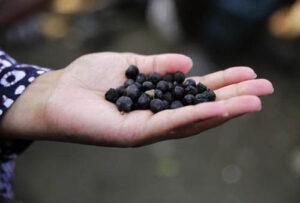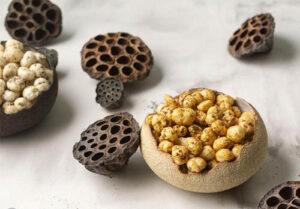Processing of Makhana
Makhana or fox nut or Gorgon nut as it is called in different countries goes through different stages of processing until the final product reaches the customer. Makhana seed is very nutritious and finds multiple uses right from cooking, to snacking, to health management, to traditional Chinese medicine etc. The processing of makhana involves various steps and can be a tedious process, most of the stages involve a lot of manual work and long working hours.
1. Seed Collection
Harvesting makhana is a labour-intensive and long process that necessitates skilled labour. The crop harvest is usually done during morning hours between 9:00 am and continues till about 3:00 to 4 :00 pm. It is difficult to take out seeds from the bottom of a pond, while relatively easier to collect seeds from a field.

2. Seeds Cleaning and Storage
Once the seeds are collected, they are stored in a horn shaped equipment called ‘Gaanja’. The process of shaking is done again in a cylindrical equipment so as to clean them further. Once cleaned, these seeds are left out in the Sun for drying for a couple of hours and then packed into smaller bags. The makhana seeds lose up to 31 percent of the moisture under direct Sunlight, this in turn makes it easy for them to be transported to the trading markets and also increase the longevity of the seeds. The seeds can be stored up to a month and also should be sprinkled with water to maintain the freshness. In the traditional system, long and cylindrical bamboo sticks are used to preserve them. These are further covered and plastered with cow dung. It is also carefully covered with a coarse cloth in order to maintain the required temperature.
3. Makhana Grading
All processed seeds are sieved multiple times for grading. The grading process includes different sizes of makhana seeds to pass through different sieving devices that are essentially rectangular iron plates , also known as ‘jharna’, in a few Indian states. The process becomes lengthy as all differently sized seeds are made to pass through up to 10 different sieves. These graded seeds are then stored safely in different packings. Grading of seed enables uniform heating of each nut during roasting and it increases the efficiency of fox nut’s processing. There are generally two grades of seeds at the producer level- lawa and thurri. While lawa is swollen and is white in colour with reddish spots, thurri is
semi-popped, is hard and is reddish in colour.
4. Pre-Heating: The sun-dried nuts are generally heated in cast iron pans or earthen pitchers by placing them over fire and stirring them continuously. The surface temperature of the pan varies from 250° C – 3000° C and time for heating is nearly 5 to 6 minutes at full capacity of the earthen pitcher.
5. Seed Tempering: The heated seeds need to be kept in ambient and appropriate conditions for up to three days, also known as the tempering of makhana seeds. This process helps in loosening the kernels within the hard seed coat.
6. Roasting and Popping of Seeds: Makhana seeds need to be roasted immediately after they have dried. This is done at high temperature and usually in a cast iron pan along with continuous stirring. This further ensures they last long, else they have the tendency to get spoilt.
Once the fried seeds cool off, then these seeds are manually cleaned, hammered with a wooden object until the white puff pops out of the black coloured seeds. With the breaking of the shell, the kernel pops out and immediately expands and becomes double of its size. This is the makhana pop or the lawa. It is important that no residue of the black seed is left on the doubly expanded white puff and kept in packets for selling them in the markets.
7. Polishing: Makhana seeds then undergo the process of polishing by rubbing the Makhana pops among themselves in bamboo baskets. Polishing smoothen the surface, provides more whiteness and lustre to the pop.
8. Packaging: A mix of lined polythene bags and also ordinary gunny bags of different sizes are used to pack popped Makhana.
Tools and Equipment Used During Post Harvesting:
There are a number of equipment and machines that are used in makhana or fox nut processing. Listed below are some of the traditionally used tools in differet parts of India.
![]() Aphara, Batna and Thaapi: These are widely used wooden tools made mostly of sheesham wood or mango wood. Aphara is a sturdy and strong platform on which roasted seeds are hit with a flat hammer again made of wood and is called Thaapi.
Aphara, Batna and Thaapi: These are widely used wooden tools made mostly of sheesham wood or mango wood. Aphara is a sturdy and strong platform on which roasted seeds are hit with a flat hammer again made of wood and is called Thaapi.
![]() Bamboo Sticks:These specially made sticks are used to stir the Makhana seeds while roasting them.
Bamboo Sticks:These specially made sticks are used to stir the Makhana seeds while roasting them.
![]() Cast Iron Pan:Cast iron pans are widely used as a cooking pan or utensil for pre-heating and roasting of Makhana seeds. These specially made pans under put in very high temperatures and also aid in uniform roasting of the seeds.
Cast Iron Pan:Cast iron pans are widely used as a cooking pan or utensil for pre-heating and roasting of Makhana seeds. These specially made pans under put in very high temperatures and also aid in uniform roasting of the seeds.
![]() Khonnghi or Deli: This tool is a small bamboo stick bucket in cylindrical shape. It is mainly used for storing raw, popped seed and in polishing operation.
Khonnghi or Deli: This tool is a small bamboo stick bucket in cylindrical shape. It is mainly used for storing raw, popped seed and in polishing operation.
![]() Mats: A number of flat mats made up of different materials are used for rying raw Makhana seeds before roasting. These mats are kept under direct Sun and facilitate uniform drying of makhana seeds.
Mats: A number of flat mats made up of different materials are used for rying raw Makhana seeds before roasting. These mats are kept under direct Sun and facilitate uniform drying of makhana seeds.
![]() Sieves: A number of different types of sieves are used during grading process. These sieves are made of iron sheets and have wooden frames. Usually seven to ten types of sieves of different mesh sizes are used for grading of raw Makhana seed.
Sieves: A number of different types of sieves are used during grading process. These sieves are made of iron sheets and have wooden frames. Usually seven to ten types of sieves of different mesh sizes are used for grading of raw Makhana seed.

Makhana Process Reengineering
There has been a shift from labour-intensive processing of makhana to mechanized processing. More machines are being used to ramp up the production and also eliminating manual roasting and splitting. Makhana grading method is also now being mechanized to overcome the crude way and reduce risks for the processors. Mechanizing the entire process is not possible, however there are a number of machines that have been developed in the last few years to improve the efficiency of the entire process.
Government role in scaling up Makhana Production
Despite all the efforts and progress, the state and centre governments still have to make a lot of stride and take a number of steps to convert the whole process from manual intensive and move on to a more mechanized way.
Sharing of know-how with other states
The knowledge sharing of makhana processes is also restricted to state of Bihar and certain other eastern states. The governments need to put in more effort into training the farmers in other states as well so that India can meet the demand for this nutritious super food across so many countries.

Meeting the Global Makhana Demand
Looking at the globally rising demand for fox nuts or makhana , there is an immediate need to ramp up the production. This again, can happen only if most stages of makhana processes are mechanized. This will lead to shorter duration of time between sowing and packaging. Also, the risk to labour will be reduced. The cumbersome and conventional manual processes need to change to modern techniques.